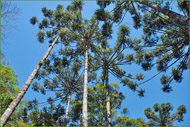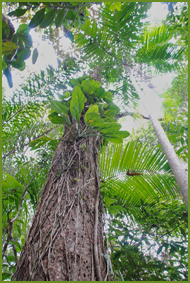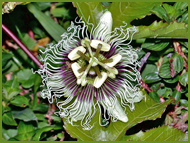The Atlantic Rainforest of Brazil (Mata Atlântica)
The Brazilian Mata Atlântica has an original extension of about 1.481.946 km², which is a portion of 17.4% of the Brazilian territory. A very high environmental heterogeneity characterizes the 3.300 km of the coastal line. This tropical forest is distributed over various topographic and climatic zones and regions, ranging from sea level to 2.700 m above sea height (Metzger, 2009).
These geographic characteristics benefit a high diversity and endemism in astonishing richness (20.000 plant species, 1.700 vertebrate species) and many species never were identified. The special importance of the region is proven by the high degree of endemism: 8.000 plant species, 700 zoological species (Myers et al. 20002; Tabarelli et al., 2005).
Photo (c) L. Scheuermann
In the Mata Atlântica region we find the biggest Brazilian urban centres (São Paulo, Rio de Janeiro, Belo Horizonte, Salvador und Curitiba), representing about 61% of total Brazilian population. This reflects a very high risk of destruction of the last remnants of the coastal rainforest (8% or 102.012 km2) (SOS Mata Atlântica/INPE, 2009).
The high occupation density reflects in a fragmentation of the Mata Atlântica remnants, consisting predominantly in secondary and advanced stages of succession – causing loss of populations and extinction of species. (Ribeiro et al., 2009; Metzger et al., 2009).
In their assessment on fragmentation of these remnants Ribeiro et al, (2009) reveal a severe situation: more than 80% of the fragments are smaller than 50 ha, having distances over 1.440 m between; the PAs represent 9% of the total forest remnants, having 1% of original, primary forest.
The high biological diversity in combination with elevated pressure on its environment makes the Mata Atlântica part of the group of the five most important ecosystems of the world, in terms of conservation of biodiversity. Mata Atlântica thus is one of the five biodiversity hotspots (Laurance 2009 7).
Mata Atlântica is the main provider in a series of ecosystem services that the Brazilian population depends on. Special mentions deserve the services: water, scenic beauty (tourism), soil conservation, food and medical products, resources for fishing, and others.
The coastal line between southern São Paulo and Paraná disposes of the largest continuous and relatively well conserved part of the Brazilian Mata Atlântica. Here is found a majestic abundance of ecosystems, going form mangrove landscapes up to the mountain ranges with 1.800 m of altitude. This special situation made UNESO declare the region as a Biosphere World Heritage (http://www.rbma.org.br). The region in biological terms is highly relevant and regarded as priority for the implementation of Brazilian Protected Areas (Edict 9 from 23.01.2007, Brazilian Federal Ministry of the Environment – MMA).
As a strategic means for conserving this important region the PA „Mosaico Lagamar“ has been implemented, comprising an area of 16.221 km2, containing 43 PAs which by this can utilize an integrated tool for administration. The mosaic concept allows combining the needs of conservation of biological diversity with the quality of life of around 350.000 inhabitants in towns and villages. Around 41.000 (17.1%) of these inhabitants are living in small, rural areas and meet their demands mainly from agriculture and the extraction of natural resources.
Even having positive legal conditions for conservation, the risks for destructing the last representative portions of the coastal rainforest are significant. Poaching, illegal extraction of natural resources like the Juçara palm and ornamental plants, logging, expansion of settlements and leisure structures, the extension of the road system (e.g. Curitiba – São Paulo) are the main scenarios of threat for the conservation of this region.
References:
Metzger, J.P., 2009. Conservation issues in the Brazilian Atlantic forest. Biological Conservation 142, 1138–1140.
Myers, N., Mittermeier, R.A., Mittermeier, C.G., Fonseca, G.A.B., Kent, J., 2000.Biodiversity hotspots for conservation priorities. Nature 403, 853–858.
Tabarelli, M., Pinto, L.P., Silva, J.M.C., Hirota, M., Bedê, L., 2005. Challenges and opportunities for biodiversity conservation in the Brazilian Atlantic Forest. Conservation Biology 19, 695–700.
Fundação SOS Mata Atlântica e Instituto Nacional de Pesquisas Espaciais, 2009. Atlas dos Remanescentes Florestais da Mata Atlântica Período 2005-2008. Relatório Técnico, 176 p.
Ribeiro, M.C., Metzger, J.P., Martensen, A.C., Ponzoni, F., Hirota, M.M., 2009. Brazilian Atlantic forest: how much is left and how is the remaining forest distributed? Implications for conservation. Biological Conservation 142, 1141–1153.
Metzger, J.P., Martensen, A.C., Dixo, M., Bernacci, L.C., Ribeiro, M.C., Teixeira, A.M.G.,Pardini, R., 2009. Time-lag in the responses to landscape changes in highly dynamic Atlantic forest region (SE Brazil). Biological Conservation 142, 1166–1177.
Laurance, W.F., 2009. Conserving the hottest of the hotspots. Biological Conservation 142, 1137.
Links
- Lei da Mata Atlântica: http://www.planalto.gov.br/ccivil_03/_ato2007-2010/2008/decreto/d6660.htm
- SOS Mata Atlântica (ONG): http://www.sosmatatlantica.org.br/
- Reserva da Biosfera da Mata Atlântica: http://www.rbma.org.br/default_02.asp
- Pacto da Mata Atlântica: http://www.pactomataatlantica.org.br/index.aspx?lang=pt-br



